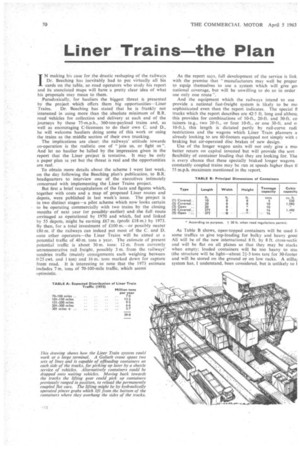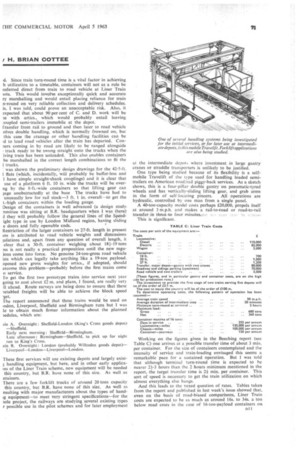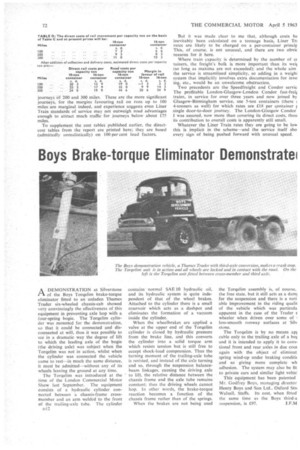Liner Trains the Plan
Page 72

Page 73

Page 74

If you've noticed an error in this article please click here to report it so we can fix it.
r H. BRIAN COTTEE IN making his case for the drastic reshaping of the railways Dr. Beeching has inevitably had to put virtually all his .cards on the table, so road operators who study his report and its associated maps will have a pretty clear idea of what his proposals may mean to them.
,Paradoxically, for hauliers the biggest threat is presented by the project which offers them big opportunities—Liner Trains. Dr. Beeching has stated that he is frankly not interested in using more than the absolute minimum of B.R. road vehicles for collection and delivery at each end of the journeys by these 75-m.p.h., 360-ton-payload trains and, as well as encouraging C-licensees to do their own C. and D., he will welcome hauliers doing some of this work or using the trains as the middle section of their own trunking.
The implications are clear: the railways' attitude towards co-operation is the realistic one of ' join us, or fight us". And let no haulier be lulled by the impression given in the report that the Liner project is tentative. It may be only a paper plan as yet but the threat is real and the opportunities are real.
To obtain more details about the scheme I went last week, on the day following the Beeching plan's publication, to B.R. headquarters to interview one of the executives intimately concerned with implementing the Liner Trains project.
But first a brief recapitulation of the facts and figures which, together with costs and a map of proposed Liner routes and depots, were published in last week's issue. The project is in two distinct stages—a pilot scheme which now looks certain to be operating commercially with two trains by the closing months of next year (or possibly.-earlier) and the full route envisaged as operational by 1970 and which, fed and linked by 55 depots, might be earning £67 m. (profit £18 m.) by 1973. By then, for a total investment of £100 m.—or possibly nearer C80 m. if the railways can indeed put most of the C. and D. onto other operators—the Liner Trains will be aimed at a potential traffic of 40 m. tons a year. The estimate of present potential traffic is about 30 m. tons: 12 m. from currently unremunerative rail freight, possibly 3 m.. from the railways' sundries traffic (mainly consignments each weighing between 0-25 cwt. and I ton) and 16 m. tons marked down for capture from road. It is interesting to note that the 1973 estimate includes 7 m. tons of 70-100-mile traffic, which seems.
optimistic. As the report says, full development of the service is link with the premise that "manufacturers may well be prepar to equip themselves to use a system which will give gal national coverage, but will be unwilling to do so in order use only one route".
And the equipment which the railways intend to use provide a national fast-freight system is likely to be mc sophisticated even than the report indicates. The special 11 trucks which the report describes are 42.5 ft. long and althou; this provides for combinations of 10-ft., 20-ft, and 30-ft. co tainers (e.g., two 20-ft., or four 10-ft., or one 30-ft. and o 10-ft.), this length is dictated partly by rail-curve radi restrictions and the wagons which Liner Train planners a already looking to are 60-footers equipped not simply with braking but air-operated disc brakes of new design.
Use of the longer wagon units will not only give a nip better return on capital invested but will provide the sort flexibility of container loading that they are looking for, The is every chance that these specially braked longer wagons constantly coupled trains may be run at speeds higher than ti 75 m.p.h. maximum mentioned in the report.
As Table B shows, open-topped containers will be used fi some traffics to give top-loading for bulky and heavy good All will be of the new international 8 ft. by 8 ft. cross-secti( and will be flat on all, planes so that they may be stack( when empty; loaded containers will be too heavy to stac (the structure will be light—about 24-3 tons tare for 30-footer and will be stored on the ground or on low racks. A stillal system has, I understand, been considered, but is unlikely to 1 d. Since train turn-round time is a vital factor in achieving Ii utilization to a timetable, containers will not as a rule be nsferred direct from train to road vehicle at Liner Train rots. This would involve exceptionally quick and accurate ry marshalling and would entail placing reliance for train n-round on very reliable collection and delivery schedules. is, I was told, could prove an unacceptable risk. Also, it expected that about 90 per cent of C. and D. work will be le with artics., which would probably entail leaving :oupled semi-trailers immobile at the depot.
fransfer from rail to ground and then later to road vehicle olves double handling, which is normally frowned on, but this case the cranage or other handling facilities can be :d to load road vehicles after the train has departed. Conners coming in by road are likely to be ranged alongside track ready to be swung straight onto the trucks when the iving train has been unloaded. This also enables contalnefs be marshalled in the correct length combinations to fit the I. trucks.
was shown the preliminary design drawings for the 42.5-ft. I flats (which, incidentally, will probably be buffer-less and I have simple straight-shank couplings) and it is clear that use of a platform 6 ft. 10 in. wide the trucks will be overng by the 8-ft.-wide containers so that lifting gear can ;age unobstructedly at the base The trucks have had to unusually low for rail stock-3 ft. 1 in. overall—to get the t.-high containers within the loading gauge.
Design of the containers is well advanced (a design studyrimittee was sitting at B.R. headquarters when I was there) I they will probably follow the general lines of the Speedight type in use by London Midland region, having sliding e doors and fully openable ends.
Restriction of the larger containers to 27-ft. length in present ins is attributed to road vehicle weights and dimensions ;ulations and, apart from any question of overall length, it clear that a 30-ft. container weighing about 181-19 tons Ass is not really a practical proposition until the new reguions come into force. No genuine 24-ton-gross road vehicle ists which can legally take anything like a 19-ton payload. oposed new gross weights for artics., if adopted, should ercome this problem—probably before the first trains come o service.
To get the first two prototype trains into service next year going to cost about £2 in. and plans, I found, are really very 11 ahead. Route surveys are being done to ensure that these netabled freights will be able to achieve the block speed The report announced that these trains would be used on rndon, Liverpool, Sheffield and Birmingham runs but I was Id to obtain much firmer information about the planned Aedules, which are: These first services will use existing depots and largely exist; handling equipment, but here, and in other early applicains of the Liner Train scheme, new equipment will be needed this country, but RR. have none of this size. As well as ntainers.
There are a few forklift trucks of around 20 tons capacity this country, but B.R. have none of this size. As well as nsulting with major manufacturers about the types of handig equipment—to meet very stringent specifications—for the note project, the railways are studying several existing types r possible use in the pilot schemes and for later employment at the intermediate depots where investment in large gantry cranes or straddle transporters is unlikely to be justified.
One type being studied because of its flexibility is a selfmobile Travelift of the type used for handling loaded semitrailers on American road/rail piggy-back services. As a sketch shows, this is a four-pillar double gantry on pneumatic-tyred wheels and has vertically-sliding lifting gear, and grab arms in the form of self-locating pincers. All operations are hydraulic, controlled by one man from a single panel.
A 40-ton-capacity model costs perhaps £20,000. propels itself at around 3 m.p.h. and makes a rail-to-road or road-to-rail transfet .in thred,,to four mirultes2i,
This is significant.
Working on the figures given in the Beeching report (see Table C) one arrives at a possible transfer time of about 3 min. per container. For the size of containers contemplated and the intensity of service and train-loading envisaged this seems a remarkable pace for a sustained operation. But I was told that although terminal turn-rdund time is expected to be nearer 21-3 hours than the 2 hours minimum mentioned in the report, the target transfer time is 2+ min. per container. This sort of speed is necessary to get the train utilization on which almost everything else hangs.
And this leads to the vexed question of rates. Tables taken from the report and published in last week's issue showed that, even on the basis of road-biased comparisons, Liner Train costs are expected to be as much as around 16s. to 34s. a ton below road costs in the case of I6-ton-payload containers on journeys of 200 and 300 miles. These are the more significant journeys, for the margins favouring rail on runs up to 100 miles are marginal indeed, and experience suggests even Liner Train standards of service may not outweigh road advantages enough to attract much traffic for journeys below about 175 miles.
To supplement the cost tables published earlier, the directcost tables from the report are printed here; they are based (admittedly unrealistically) on 100 per cent load factors.
But it was made clear to me that, although costs ha inevitably been calculated on a tonnage basis, Liner Tr: rates are likely to be charged on a per-container princiF This, of course, is not unusual, and there are two obvic reasons for it here.
Where train capacity is determined by the number of cc tainers, the freight's bulk is more important than its well (so long as maxima are not exceeded); and the whole aim the service is streamlined simplicity, so adding in a weigh] system that implicitly involves extra documentation for invo ing, etc., would be an unwelcome obstruction.
Two precedents are the Speedfreight and Condor servic The profitable London-Glasgow-London Condor fast-freii trains, in service for over three years and now joined by Glasgow-Birmingham service, use 5-ton containers (there 4-tonners as well) for which rates are £18 per container I single door-to-door journey. The London-Glasgow Condor I was assured, now more than covering its direct costs, thou its contribution to overall costs is apparently still small.
Whatever the Liner Train rates they are going to be to this is implicit in the scheme—and the service itself sho every sign of being pushed forward with unusual speed.








































































































































